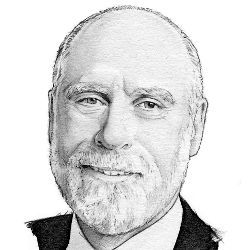
I was chatting with Alex Wolf, vice president of ACM, at an Executive Committee meeting that took place shortly after the spectacular announcement of the confirmation of post-Big Bang inflationary expansion of the Universe—a notion that had been posited in 1980 by Alan Guth. Alex pointed out that scientific measurement and confirmation of the theory took 34 years to materialize. His observation struck a chord. Too often one gets the impression of tacit expectation that scientific research has to produce results within some predictable time or it is not useful or relevant.
I was immediately reminded of two other predictions that took some time to confirm. The most recent before the inflation result was the discovery of the Higgs boson that propagates the Higgs Field, conferring mass upon subatomic particles. Peter Higgs had predicted the existence of this particle in 1964. Nearly 50 years later, the Large Hadron Collider at CERN was able to measure clear evidence of the existence of a massive particle matching the Higgs boson’s anticipated characteristics.
The other is the discovery of the pi muon or pion. From Wikipedia (http://en.wikipedia.org/wiki/Pion) we learn: "Theoretical work by Hideki Yukawa in 1935 had predicted the existence of mesons as the carrier particles of the strong nuclear force. From the range of the strong nuclear force (inferred from the radius of the atomic nucleus, Yukawa predicted the existence of a particle having a mass of about 100MeV. Initially after its discovery in 1936, the muon (initially called the "mu meson") was thought to be this particle, since it has a mass of 106 MeV. However, later particle physics experiments showed that the muon did not participate in the strong nuclear interaction.
"In 1947, the first true mesons, the charged pions, were found by the collaboration of Cecil Powell, César Lattes, Giuseppe Occhialini et al., at the University of Bristol, in England. Since the advent of particle accelerators had not yet come, high-energy subatomic particles were only obtainable from atmospheric cosmic rays. Photographic emulsions, which used the gelatin-silver process, were placed for long periods of time in sites located at high altitude mountains, first at Pic du Midi de Bigorre in the Pyrenees, and later at Chacaltaya in the Andes Mountains, where they were impacted by cosmic rays."
These are by no means the only examples of the delay between theoretical prediction and practical discovery, but they serve to illustrate the point that it may take some time to validate the results of theoretical research. In some cases, the delay results from the lack of instruments to discover corroborating measurements. I am reminded of the so-called Ice Cubea experiment in Antarctica funded by the National Science Foundation. It required an enormous effort to construct the 5,000 sensors buried deep in the ice and designed to detect powerful cosmic ray neutrinos originating in galactic and extragalactic supernovae while ignoring low power solar neutrinos. This work was rewarded by the detection of more than two dozen extremely energetic neutrinos, the most powerful of which were named after Sesame Street characters: Bert, Ernie, and Big Bird. (Even serious scientists have a sense of humor!)
The endless pas de deux between theory and practice is well illustrated by these examples. In some cases, measurement corroborates theory and in others it contradicts the theory. Once other possible sources of measurement error are discarded, scientists may be forced to alter theory to explain measurement. This is the essence of scientific principle: corroboration of theory with measurement, duplication of results by others to confirm observations, and revision of theory to explain measurement. That these confirmations or refutations may take decades to achieve is part of the long-term process of scientific investigation. As debates about the utility of scientific research ensue during annual budget-setting exercises, we would do well to remember the story of the Higgs boson, the pi muon, and the cosmic background measurements confirming inflationary expansion after the Big Bang. Sometimes it takes time, patience, and a lot of effort to establish and confirm scientific theory. It is worth the wait and the expense.
Vinton G. Cerf, ACM PRESIDENT



Join the Discussion (0)
Become a Member or Sign In to Post a Comment